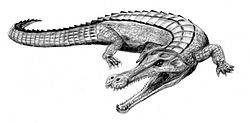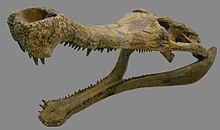Sarcosuchus
| Sarcosuchus | ||||||||||||
|---|---|---|---|---|---|---|---|---|---|---|---|---|

Replica of a Sarcosuchus imperator |
||||||||||||
| Temporal occurrence | ||||||||||||
| Lower to Upper Cretaceous ( Albium to Cenomanium ) | ||||||||||||
| 112.9 to 93.9 million years | ||||||||||||
| Locations | ||||||||||||
|
||||||||||||
| Systematics | ||||||||||||
|
||||||||||||
| Scientific name | ||||||||||||
| Sarcosuchus | ||||||||||||
| Broin & Taquet , 1966 |
Sarcosuchus is an extinct genus of Neosuchia . It was an animal with a body length of up to 11 meters that lived during the Lower and Early Upper Cretaceous ( Albium to Cenomanium ) in what is now Africa . In the English-speaking world it became popular under the name "SuperCroc".
features
Sarcosuchus imperator , the only species, has so far been found in two places in Africa and was first described in 1964 on the basis of skull remains from the Ténéré desert in Niger . A further illustration with skeletal parts of five adult individuals, including a complete skull, as well as young animals was made in 2001, also from fluvial deposits from the Lower Cretaceous ( Apt / Alb ) Niger.
The animal's narrow snout made up about 75% of the approximately 1.6 meter long skull. At the same time, however, it was significantly wider than the gavials and other narrow-snouted crocodiles living today . The dentition consisted of five large teeth in the premaxillary on both sides, 30 teeth on both sides in the main part of the upper jaw ( maxillary ) and 31 teeth on both sides in the lower jaw , with individual teeth being significantly enlarged. There was no tooth gap as in the real crocodiles (Crocodylidae) living today , in which there was space for enlarged teeth on the opposite side. The lower jaw was shortened by 10 centimeters compared to the upper jaw and was overlapped by this at the front end. The nasal space at the end of the snout was noticeably enlarged.
A maximum length of 11 to 12 meters was extrapolated as the body length for Sarcosuchus due to the skull dimensions ; more precise information is not possible, as a complete skeleton is not yet available. With these dimensions, the species is one of the largest known Crocodylia so far, only for Rhamphosuchus from the Pliocene of India, Deinosuchus from the late Cretaceous, Purussaurus and Mourasuchus from South America and Gavialosuchus from North America, similar dimensions can be assumed. However, the forms known only from a few finds, such as Purussaurus, could have been significantly larger than Sarcosuchus . Individual bones of Purussaurus suggest animals with a length of 17 meters; such a crocodile would have been as big and heavy as a smaller bull sperm whale . The weight of Sarcosuchus should have been about eight tons and the maximum size was reached according to the evaluation of thin sections of osteoderms (bony plates in the bone armor ) around the age of 50 to 60 years.
Way of life
Sarcosuchus imperator was an amphibious inhabitant of fresh water and probably also of brackish water . Its snout, which is relatively broad at the tip and the large, rounded, and for a Crocodylia that lives exclusively on fish, in relation to its short teeth, as well as its body size, distinguish it as a predator with a wide range of prey. He probably not only hunted fish, but also hunted larger animals on the bank , similar to today's Nile crocodile ( Crocodylus niloticus ), including probably dinosaurs .
Systematics
Sereno et al. 2001 tried to determine the closer relationship of Sarcosuchus imperator on the basis of the bones available to them. Most of the features spoke for a classification in the Neosuchia (a group within the Mesoeucrocodylia ), so the modern crocodile forms. Due to the similarities in the skull structure, especially the widened nasal cavity and the elongated snout, the North American crocodile Terminonaris is assumed to be a sister species . Pholidosaurus and Dyrosaurus are also likely to be closely related , which is why the entire group is known as Pholidosauridae . In contrast to Sarcosuchus , all these species are fish-eaters that lived on the seashore. If this relationship hypothesis is confirmed , it can be assumed that Sarcosuchus has developed in adaptation to a new habitat in the area of rivers.
The following cladogram shows the relationship hypothesis according to Sereno et al. 2001:
| Neosuchia |
|
||||||||||||||||||||||||||||||||||||
|
|
literature
- Paul C. Sereno , Hans CE Larsson, Christian A. Sidor, Boubé Gado : The Giant Crocodyliform Sarcosuchus from the Cretaceous of Africa. In: Science . Vol. 294, No. 5546, 2001, pp. 1516-1519, doi : 10.1126 / science.1066521 .


